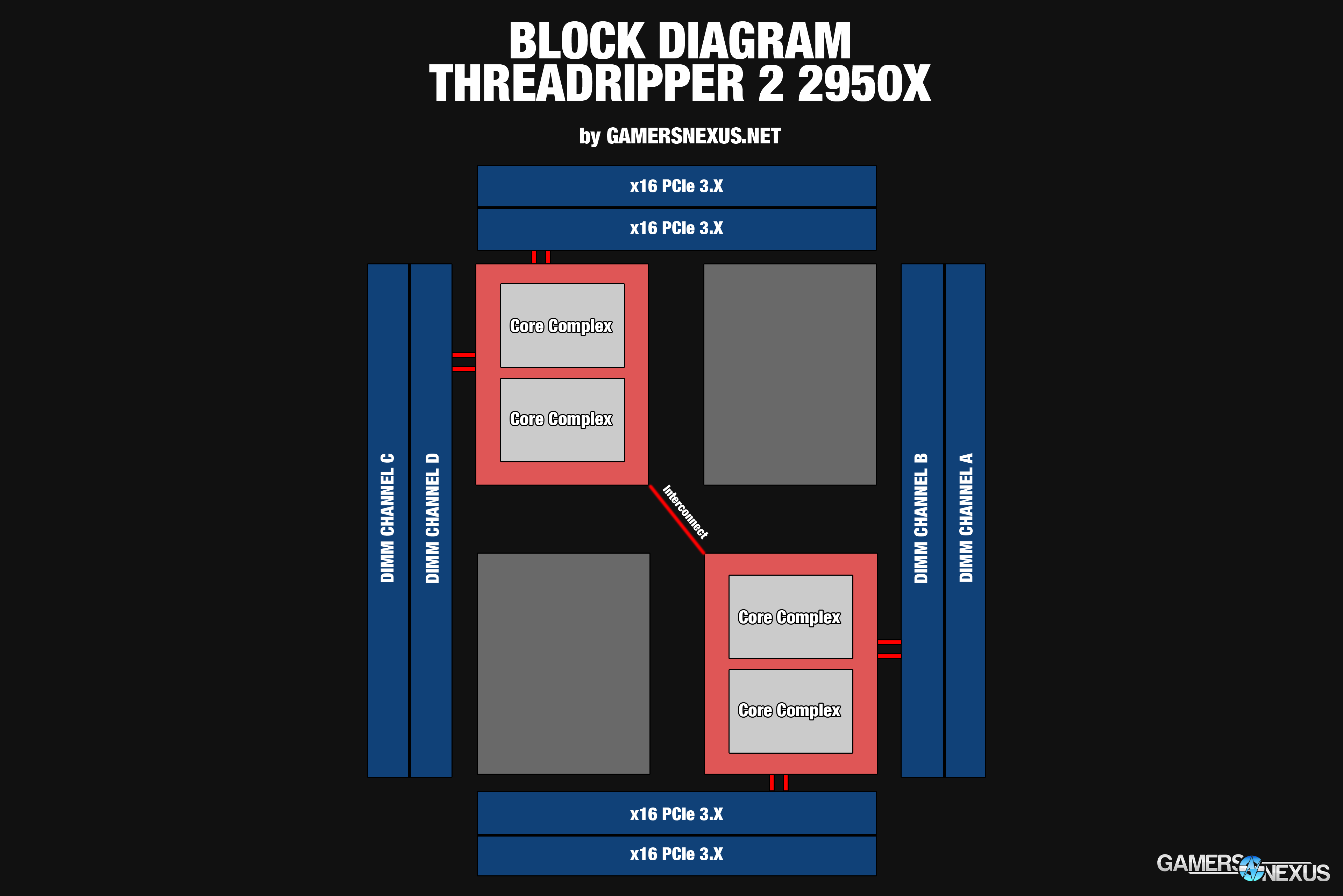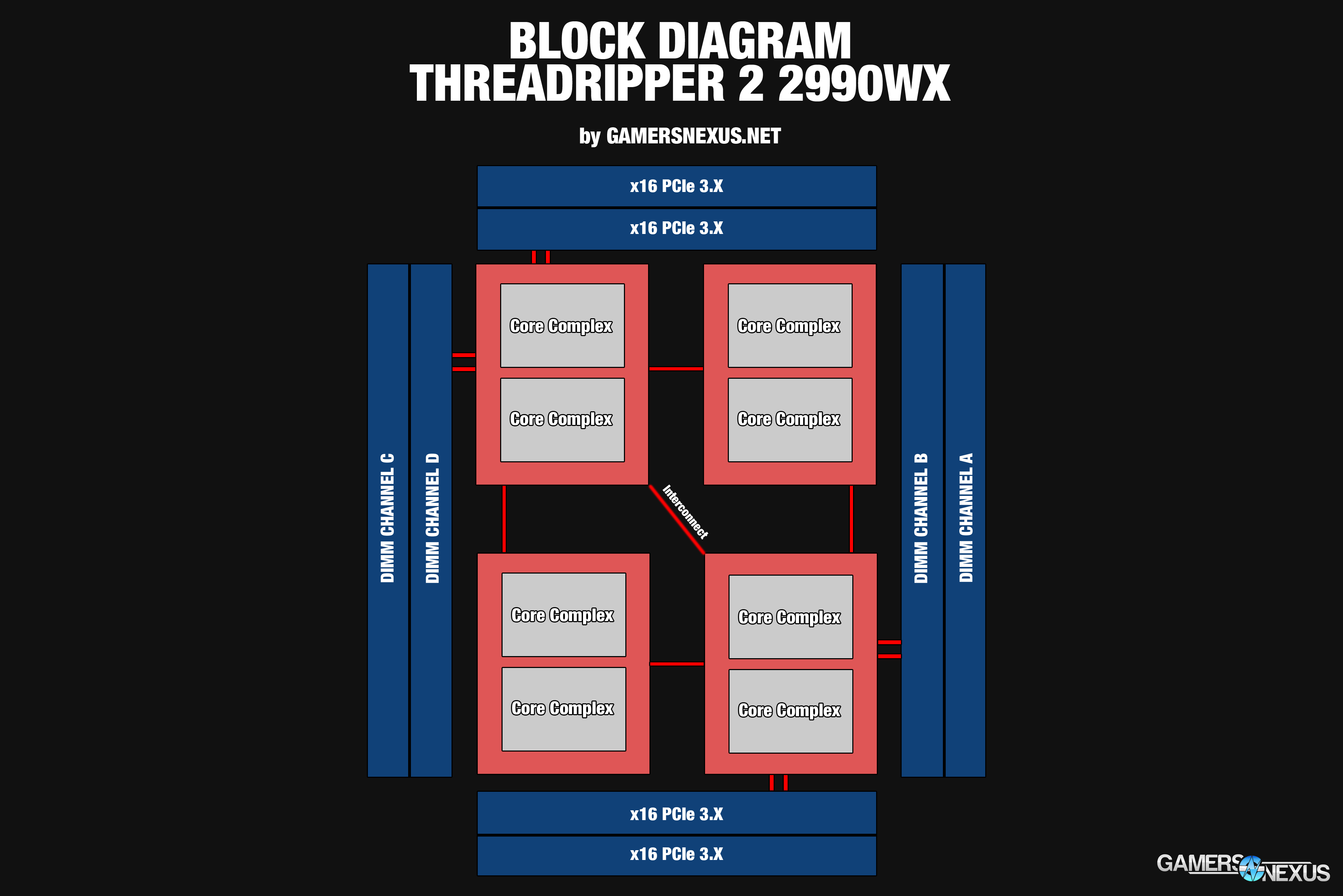AMD’s new Threadripper 2 CPUs are slated for launch in the immediate future. We have AMD Threadripper 2 specs, prices, and topological information for the 2990WX, 2970WX, 2950X, and 2920X, most of which have been detailed today. Additional details and reviews are pending publication from sampled outlets. We are not technically working with AMD on this launch, but are looking into review/test options. These will likely be pushed back past our move-in for the new office.
The new AMD Threadripper 2 2990WX will use cores enabled in dies 0, 1, 2, and 3 – so all 4 of the dies under the IHS – which more or less confirms Der8auer’s findings earlier this year. The 2950X and 2920X will be using dies 0 and 1, leaving the other two unutilized.
Improvements over Threadripper 1 include the same stuff we saw in Ryzen 2000 CPUs. This includes a cache latency drop of 15% for L3 cache, 9% for L2 cache, and 8% for L1 cache. DRAM latency was also reduced by 2%, and official JEDEC support has increased from 2666MHz to 2933MHz.
Here’s an image we made that shows AMD’s Threadripper 2 SOC topology. It’s not much different than the 1950X at its core: this is the 2950X, using two memory channels to connect dies to memory, 32 PCIe lanes each, and IO operating at 50Gbps with a 1600MHz memory clock. Cores 0-15 are on die 0 in the diagram, with cores 16-31 on die 1. In theory, AMD is enabling the same two dies in every processor, so hotspots shouldn’t change in TR2. This is good news for cooling manufacturers. As for the memory channels, like Threadripper 1, these can be pooled into a single UMA domain rather than two NUMA domains. This is user-configurable and depends on whether you want latency for gaming or pools for production. Local Mode, or NUMA, I suseful for reducing memory latency, while UMA is ideal for even spread of memory hits across channels.
This image shows the 2990WX block diagram. It’s not too different, but gets a bit more complex when given the extra two dies. Dies 0 and 2 hold the direct buses to PCIe and DDR, with dies 3 and 1 simply sitting between infinity fabric lines to the main IO controller dies.
Threadripper 2 will be on 12nm LP, or “Leading Performance.” This is largely what enables the clock speed increase that was seen in Ryzen 2000, and has carried over to Threadripper 2.
The CPU specs for Threadripper 2 include the following:
AMD Threadripper 2 CPU Specs | GamersNexus.net | ||||
TR-2920X | TR-2950X | TR-2970WX | TR-2990WX | |
Cores/Threads | 12/24 | 16/32 | 24/48 | 32/64 |
Base/Boost | 3.5/4.3GHz | 3.5/4.4GHz | 3.0/4.2GHz | 3.0/4.2GHz |
L2 | [unconfirmed] | 512K/core | [unconfirmed] | 512K/core |
L3 | [unconfirmed] | 16MB/die | [unconfirmed] | 16MB/die |
Die Topology | Active: 0, 1 | Active: 0, 1 | [unconfirmed] | Active: 0, 1, 2, 3 |
Transistor Count | [unconfirmed] | 9.6B | [unconfirmed] | 19.2B |
TDP | [unconfirmed] | 180W | [unconfirmed] | 250W |
PCIe Gen3 Lanes | 64 | 64 | 64 | 64 |
MSRP | $650 | $900 | $1,300 | $1,800 |
CPUs:
- 2920X 12C/24T: 3.5GHz to 4.3GHz XFR2, $650. Most immediately replaces the 1920X, which is presently $520 – we’ll link it below – and runs up to 4.2GHz. 2920X ships October.
- 2950X 16C/32T: 3.5GHz to 4.4GHz, $900. Replaces the 1950X of the same core count. 1950X capped at 4.0GHz and sells for around $780 today. Ships August 31.
- 2970WX: 24C/48T, 3.0GHz to 4.2GHz, $1300. New CPU line for AMD. Ships October.
- 2990WX: 32C/64T, 3.0GHz to 4.2GHz, $1800. Ships August 8. 64 PCIe lanes, still quad channel, runs 4x 213mm^2 dies. Same L2 and L3 cache as the 2950X, which should prove interesting for some benchmarks. 250W TDP.
Speaking of TDP, AMD’s formula for calculating TDP is a bit different from Intel’s and NVIDIA’s. That doesn’t necessarily mean any vendor is wrong, just that they all do it differently. AMD calculates TDP for the 2950X as follows: TDP in Watts = (tCase *C – tAmbient *C)/(HSF thermal resistance) [degrees Celsius per watt]. AMD calculates its 180W TDP by taking a 56-degree optimal processor lid temperature and subtracting a 32-degree ambient temperature, then calculates versus a 0.133 thermal resistance.
As for TCTL, like last time, it will remain 27 degrees offset.
Performance notes are limited primarily to the below:
- Despite making a fuss about media testing games at 1080p last year, AMD’s Performance Labs endnotes do indicate that their gaming suite testing was done at 1080p. That’s how you show a difference. Regardless, AMD showed, on average, about a 6% decline versus Intel when comparing for similarly priced parts. That’s not bad when considering the initial Ryzen deficit in gaming, and considering the significant performance uplift promised in production applications. Overall, taking AMD’s testing at face value, this is a promising depiction of Threadripper 2’s performance potential.
- H100i CLCs were used in all of AMD’s 2950X tests and 2990WX stock tests, indicating that thermals are under control if not overclocked and if running at controlled voltages. Overclocking will produce a lot more heat.
That’s all for now. We may be testing this one, but aren’t clear yet. Depends on (1) our move timeline, and (2) our ability to pull samples from third parties, or to purchase them.
Editorial: Steve Burke
Video: Keegan Gallick

